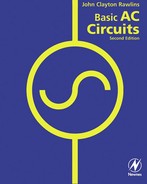Preface
As with the first edition, this textbook is designed for the person continuing a study of basic electricity. It provides the general information, theory, and problem-solving techniques required for an analysis and application of alternating current (ac) circuits — from the simplest to the most complex. Its aim is to help provide a solid foundation for the person interested in learning the concepts and principles of basic electricity and then, if the opportunity arises, in advancing in the studies of physics, electronics, computer science, and engineering. The book is written both as a textbook for classroom students and instructors and as a textbook for individualized learning. It has been written and organized in a way that will help the reader best acquire the knowledge necessary to analyze ac circuits, and to gain a basic understanding of some of the measurement techniques used in such analysis. Each chapter has specific objectives, detailing exactly what the reader should know or be able to do after completing the chapter.
Even though a knowledge of simple algebra and a basic understanding of direct current (dc) circuits is assumed, new concepts and terms and the necessary mathematics are introduced as needed with illustrative examples. Detailed computations are carried out step by step so that algebraic methods, the use of exponents, and scientific notation are easily understood.
The book begins with an introduction to alternating current — how an alternating voltage is generated and why the sine function describes the characteristics of such a voltage and the resulting circuit current.
Because the oscilloscope is such a valuable measuring tool for observing alternating voltages and currents, a chapter is devoted to describing it before continuing with resistive ac circuit analysis.
New concepts of capacitance and inductance and their action in ac circuits are discussed, and then respective circuit analysis techniques are covered for series and parallel resistive-capacitive and resistive-inductive circuits. Contained within the inductance chapter is the important discussion of mutual inductance and transformers.
Because the reaction of inductance and capacitance in circuits that have time-varying voltages that produce time-varying currents is important to ac circuit analysis, a chapter on time constants for resistive-capacitive and resistive-inductive circuits is included.
Building on prior chapters, more complex circuit analysis continues by including resistive, capacitive, and inductive components all at the same time in series, parallel, and combination series-parallel ac circuits. Right triangle analysis is replaced by phasor algebra with the introduction of imaginary numbers so that the techniques of analyzing the most complex ac circuit are presented.
A discussion of the special case in ac circuits where the ac frequency is varied to resonance completes the text.
The text is written not to support theories with complete rigid mathematical proofs, but to explain the fundamental ideas so the reader may understand how to put electricity to use in practical ways. Hopefully the text succeeds in achieving that goal.
The author wishes to express appreciation to the companies that provided permission to use their instruments and printed materials to help in the production of this text. A debt of gratitude is due Stanley R. Fulton, who was the co-author of the first edition, who made numerous excellent contributions to that edition and provided encouragement to the author to undertake the writing of the first edition, and who is also a very good friend. Also, much thanks is due Patricia Rawlins, the author!’s wife, who typed the original manuscript of the first edition. Without these contributions, neither the first nor the second edition would have been feasible.
Finally, the author would like to thank the staff at Butterworth-Heinemann including Candy Hall, Pam Chester, Kevin Sullivan, and numerous others behind the scenes who contributed to the production of the second edition.
